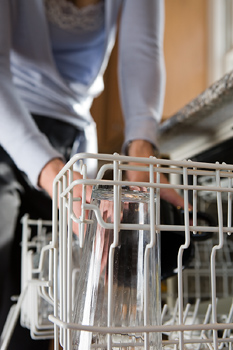How to Install a Dishwasher
Doing it yourself doesn’t require the services of a contractor, so save money on your next home installation by learning how to install a dishwasher yourself. While dish washer installation isn’t hard, there are one or two safety steps to keep in mind.
Turn off the Utilities
Turn off the circuit break that controls power to your kitchen, so no electricity is throwing through the sockets you’re going to be working around. Electricity safety is key when installing new household appliances.
Next, turn off the water main flowing into your house and kitchen. You should find this in your yard somewhere. Also, shut off the hot water pipe underneath your sink, to make sure residual hot water doesn’t link into your work area. Make sure any standing water or pipe water is removed before you begin.
Remove Your Old Dishwasher
Assuming you have an old dishwasher in your kitchen, unscrew clamps or screws that are holding the dishwashing appliance in place. Disconnect any pipes or electrical cords that are attached from your appliance to the kitchen.
Remove your old dishwasher with the help of a friend. The dishwasher is heavy enough that one person doesn’t need to try manipulating it alone.
Inspect the Dishwasher Space
Now that you have the old dishwasher out of the way, inspect the empty space and learn what you have available to you. Learn where the holes for cords and pipes run, and the best way to reattach an appliance. You should have holes in your cabinet running to your sink drain and from your water supply, as well as a hole for a power cord. Drill holes if none exist.
Install a Dishwasher Air Cap
Remove the hole plug with a quick hammer punch. This shouldn’t take too much trouble. Once this is done, install the air hose and air gap underneath the sink, setting them in place with slip joint pliers and a locknut. Make sure the air gap cover faces towards the sink drain.
Installing the Dishwasher

How to Install a Dishwasher
Next, move the new dishwasher in the vicinity of your dishwasher hole, leaving enough room to maneuver. Attack water supply tubes through the aforementioned holes. Position the dishwasher in its place without pinching any connectors.
Attach electrical cords through the protective sleeve, then attach the wires by color. Attach the ground wire, which should be green (that is, green wire to green wire). Attach the white wire with white wire, then the black wire with black wire. Once this is done, plug the electric cord into the wall socket.
Connect Water Supply
Attach the water supply tube from the sink to your valve. Look for the flexible looking tube, then attach it to the valve’s second outlet. Secure the tube by tightening with a wrench.
Clamp the Short Drain Hose
The short drain hose is going to connect to the garbage disposal, if you have one, as well as the large outlet on the air gap. Pinch clamps on both ends of the shorter drain hosing, then do the same with the long drain hose, which should go on the drain outlet at the bottom of the new dishwasher appliance.
Check Your Work
Before you shove the dishwasher fully into your cabinet nook, make certain every connection is tight and the wiring and washer fits. Align the dishwasher with the countertop and your cabinets, to make sure everything looks nice and uniform.
Once this is done, make certain the dishwasher sets in place, by screwing the dishwasher into the counter. Turn on the circuit breaker and your water supply and run a cycle, to check for any leaks or other problems.
Installing a Dishwasher
Learning how to install a dishwasher from scratch doesn’t require electronic knowledge or handyman skills, but it’s a good idea to have your installation manual beside you as you work. Every new dishwasher should have an owners manual. If you have any other questions, don’t be afraid to ask the handiest person in your family, or even that neighbor who seems to know about handiwork.
Resources
- Hammerzone.com: Installing a New Dishwasher
- Open Directory: Home: Consumer Information: Appliances: Dishwashers
